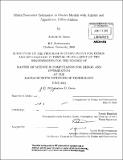| dc.contributor.advisor | Patrick Heimbach. | en_US |
| dc.contributor.author | Davis, Andrew D. (Andrew Donaldson) | en_US |
| dc.contributor.other | Massachusetts Institute of Technology. Computation for Design and Optimization Program. | en_US |
| dc.date.accessioned | 2012-09-13T18:57:57Z | |
| dc.date.available | 2012-09-13T18:57:57Z | |
| dc.date.copyright | 2012 | en_US |
| dc.date.issued | 2012 | en_US |
| dc.identifier.uri | http://hdl.handle.net/1721.1/72868 | |
| dc.description | Thesis (S.M.)--Massachusetts Institute of Technology, Computation for Design and Optimization Program, 2012. | en_US |
| dc.description | Cataloged from PDF version of thesis. | en_US |
| dc.description | Includes bibliographical references (p. 75-77). | en_US |
| dc.description.abstract | The cryosphere is comprised of about 33 million km³ of ice, which corresponds to 70 meters of global mean sea level equivalent [30]. Simulating continental ice masses, such as the Antarctic or Greenland Ice Sheets, requires computational models capturing abrupt changes in ice sheet dynamics, which are still poorly understood. Input parameters, such as basal drag and topography, have large effects on the applied stress and flow fields but whose direct observation is very difficult, if not impossible. Computational methods are designed to aid in the development of ice sheet models, ideally identifying the relative importance of each parameter and formulating inverse methods to infer uncertain parameters and thus constrain ice sheet flow. Efficient computation of the tangent linear and adjoint models give researchers easy access to model derivatives. The adjoint and tangent linear models enable efficient global sensitivity computation and parameter optimization on unknown or uncertain ice sheet properties, information used to identify model properties having large effects on sea-level. The adjoint equations are not always easily obtained analytically and often require discretizing additional PDE's. Algorithmic differentiation (AD) decomposes the model into a composite of elementary operations (+, -, *, /, etc ... ) and a source-to-source transformation generates code for the Jacobian and its transpose for each operations. Derivatives computed using the tangent linear and adjoint models, with code generated by AD, are applied to parameter estimation and sensitivity analysis of simple glacier models. AD is applied to two examples, equations describing changes in borehole temperature over time and instantaneous ice velocities. Borehole model predictions and data are compared to infer paleotemperatures, geothermal heat flux, and physical ice properties. Inversion using adjoint methods and AD increases the control space, allowing inference for all uncertain parameters. The sensitivities of ice velocities to basal friction and basal topography are compared. The basal topography has significantly larger sensitivities, suggesting it plays a larger role in flow dynamics and future work should seek to invert for this parameter. | en_US |
| dc.description.statementofresponsibility | by Andrew D. Davis. | en_US |
| dc.format.extent | 77 p. | en_US |
| dc.language.iso | eng | en_US |
| dc.publisher | Massachusetts Institute of Technology | en_US |
| dc.rights | M.I.T. theses are protected by
copyright. They may be viewed from this source for any purpose, but
reproduction or distribution in any format is prohibited without written
permission. See provided URL for inquiries about permission. | en_US |
| dc.rights.uri | http://dspace.mit.edu/handle/1721.1/7582 | en_US |
| dc.subject | Computation for Design and Optimization Program. | en_US |
| dc.title | Multi-parameter estimation in glacier models with adjoint and algorithmic differentiation | en_US |
| dc.type | Thesis | en_US |
| dc.description.degree | S.M. | en_US |
| dc.contributor.department | Massachusetts Institute of Technology. Computation for Design and Optimization Program | |
| dc.identifier.oclc | 808368448 | en_US |
